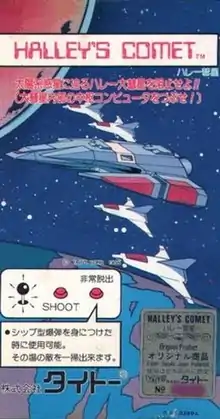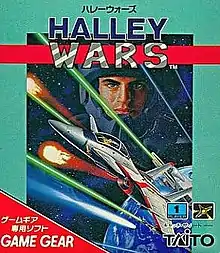Halley's Comet (video game)
Halley's Comet is an arcade video game created by Pacific Manufacturing Ltd and manufactured by its parent company Taito.[1] Receiving a worldwide release in 1986, Halley's Comet is a vertically scrolling shooter where the player defends various planets around the solar system from a direct collision with Halley's Comet and the various alien swarms which accompany it.
| Halley's Comet | |
|---|---|
 | |
| Developer(s) | Taito |
| Publisher(s) | |
| Designer(s) | Fukio Mitsuji |
| Composer(s) | Hisayoshi Ogura |
| Series | Halley |
| Platform(s) | Arcade, i-mode, Yahoo Mobile |
| Release | |
| Genre(s) | Vertically scrolling shooter |
| Mode(s) |
|
| Arcade system | Taito SJ System |
Gameplay

The game opens with the player above Earth with the message "Defend the Earth from comets!". The player ship must navigate two stages per planet in the solar system (including Pluto, as the game was released well before the re-classification of Pluto in 2006.) As enemy waves spawn at the player, all surviving enemy ships, and in rare cases, shots, will proceed past the player down a mini-map on the right-hand side of the screen and impact the planet. Each impact causes a 1% increase to the planet's damage. If the planet hits 100%, the game is over, regardless of the remaining stock of player lives.
The first stage of each planet is divided by a mini-boss fight. This encounter is a large ship that fires large bullets in clusters at the player while standard enemy waves continue to spawn. The second half of the first stage ends with an encounter with the "comet" which will share the same colour as the planet being defended (blue for Earth, yellow for Venus, Red for Mars, and so on). The comet boss will open a small section of its exterior, revealing a small patch of circuitry from which a bullet will spawn. When the player destroys 5 such openings, the comet will explode and allow the player ship to enter the comet, starting stage two for that planet.
Stage two for each planet encounter takes place inside the comet, which appears to be an alien ship. Enemy waves continue to spawn until the player reaches the main boss for that planet. A large ship with 10 orange targets that will alternate between covered and uncovered, fires a bullet for each active target when opened. When the player destroys each of the targets, the boss explodes, and the planet is saved. The screen then changes to a bonus point calculation where points are awarded based inversely on the amount of damage the planet has taken during the level.
The planet encounter order is as follows:
Earth → Venus → Mercury → Mars → Jupiter → Saturn → Uranus → Neptune → Pluto → The Sun
Easter eggs and errors
If, during the opening of any planet level, the player ship is made to move over the words "Save the [planet name] from Comets!", the text will be erased in the wake of the ship. If more than 2 characters are affected, a line of text appears above this text that reads "DO NOT ERASE!"
The opening text keeps the word "the" static for each planet, so while the "Earth" and "Sun" encounters make sense with this structure, other planets will read "Save the Venus from Comets!".
Enemy ship sprites will occasionally get stuck in the outer borders of the screen. This was not typically visible on old cabinets with wider margins on the old CRT monitors, but modern CRT or flat screens will still show these errors. The stuck sprites do not fire and cannot be destroyed. They disappear when the screen refreshes after a level or if a new ship flies through the stuck sprite.
Power-ups
To assist the player in his fight, many power-ups are available. Power-ups are hidden in small asteroids in the first stage of the game, and gray boxes in the second stage. Power-ups appear in the same cycle, whether the player collects them or not.
They go: Triple shot, which gives a secondary beam on either side of the main shot → mini ship, which flanks the player ship in a "V" pattern (up to four per side) → main cannon upgrade, which increases the size of the main shot → Spread shot, which adds a bullet that fires outward from the center of the ship in a "V" shape → speed boost, which increases the player ship's movement speed on screen → and a wildcard power-up that can either max out all player ship shots, give the player a full complement of mini ships, destroy everything on screen, or add a shield to the front of the player ship that will stop bullets. All power-ups "stack" to give an increased effect with multiple pickups of the same power up, increased size in the case of player bullet/beam power-ups, more mini-ships, or faster move speed.
Picking up mini ships increases the player's firepower such that when they are picked up they fall in on the player's left and right wings and fire single shots as the player fires. By pressing the Hyperspace button, a mini ship can be used as a screen-clearing smartbomb.
Development and release
Halley's Comet was designed by Bubble Bobble creator Fukio "MTJ" Mitsuji.[2] The music was scored by Hisayoshi Ogura.[3] Mitsuji recounted its development process in a 1988 interview with Japanese magazine Beep, stating that the project originated from a conversation the staff had with the then-president of Taito about creating a title based on Halley's Comet.[2] Mitsuji regarded the game to be important for him, as it started his development philosophy based on "thrills and pleasures".[2] Mitsuji remarked that the PCB used for the title was underpowered and had no hardware-scrolling support, prompting the team to work with effort under severe limitations on making the background look as if it was scrolling.[2]
Halley's Comet was first released by Taito in Japan in January 1986 and later by Coin-it in North America on April of the same year.[4] The game was later ported to Japanese mobile phone platforms such as i-mode and Yahoo Mobile under the title Halley Wars between January 15, 2003 and January 16, 2004 respectively.[5][6][7] Between 2007 and 2008, the title was also included as part of volume 2 in the Taito Memories II Gekan and Taito Memories II: Eternal Hits compilations for PlayStation 2.[8][9] In 2021, it was re-released for PlayStation Network and Nintendo eShop by Hamster Corporation as part of their Arcade Archives series.[10]
Reception
In Japan, Game Machine listed Halley's Comet on their March 15, 1986 issue as being the second most-popular arcade game at the time.[11] In North America, Play Meter listed the game to be the eight most-popular arcade game at the time.[12] However, the Japanese book Revived 20th Century Arcade Game Encyclopedia Vol. 2 gave the title a negative review.[3] Cave programmer Hiroyuki Uchida stated in a 1998 interview that its gameplay served as a basis for Dangun Feveron.[13] Likewise, former Toaplan composer Tatsuya Uemura claimed in a 2009 interview that Twin Cobra was influenced by Halley's Comet, as he wanted to portray the feeling of aiming and shooting.[14]
Legacy
| Halley Wars | |
|---|---|
 Halley Wars Japanese Game Gear cover art | |
| Developer(s) | Taito |
| Publisher(s) | Sega |
| Platform(s) | Game Gear Family Computer Disk System |
| Release | |
| Genre(s) | Action Sci-fi Shoot 'em up |
| Mode(s) | Single-player |
A sequel, called Halley Wars is a vertical space scrolling shoot 'em up which was released on the Family Computer Disk System and later on the Game Gear.
It is set in the middle of the 21st century. The armies of Lord Halley are launching attacks on planet Earth using Halley's Comet as the spearhead of the attack. The player represents the last chance for Earth piloting a craft specially developed to engage the enemy hordes. The game has six long stages set in locations in space such as above planets, inside enemy vessels or in asteroid fields. There is always a big boss at the end of each stage each with its own weakness. There are power-ups, which can be picked up along the way when the player shoots particular asteroids or satellites. These upgrade their weapon strength, speed, shields and add small drone wingmen ships which assist in firing. The enemies mostly attack in waves with similar types of vessel attacking together in formation.
The game is unusual in the way any enemies or comet debris not destroyed on the journey make it to earth and do some damage there. Comets do more damage than the enemy ships do. If Earth's damage level reaches 100% the game ends. For every 2,000 points scored, 1% of Earth's damage is repaired, continuing also resets the damage to 0 but the player loses their score and weapon powerups. There are three difficulty settings: Easy, Medium and Hard with each progressively having more, new and tougher enemies.
References
- Exchanger (March 1986). "Video Game: すい星接近!!君は地球を魔の手から守れるか - 八レ-ずい星". Micom BASIC Magazine (in Japanese). No. 45. The Dempa Shimbunsha Corporation. pp. 236–237.
- "開発者インタビュー - 三辻富貴朗". Beep (in Japanese). SoftBank Creative. 1988. (Translation by Shmuplations. Archived 2020-10-22 at the Wayback Machine).
- 1986年 - ハレーズコメット. 甦る 20世紀アーケードゲーム大全 (in Japanese). 2 (アクションゲーム・シューティングゲーム熟成期編 ed.). Media Pal. 20 December 2019. p. 33. ISBN 978-4802110419.
- Akagi, Masumi (13 October 2006). タイトー (Taito); Coin-it/Monroe Mfg.; Taito America; H. アーケードTVゲームリスト 国内•海外編 (1971-2005) (in Japanese) (1st ed.). Amusement News Agency. pp. 43, 114, 137, 154. ISBN 978-4990251215.
- Sei, Sekiguchi (January 9, 2003). "タイトー、J-スカイ向けゲーム配信サイトに新作追加". K-Tai Watch (in Japanese). Impress Corporation. Archived from the original on 2020-02-01. Retrieved 2020-11-21.
- Tanaami, Yohei (January 10, 2003). "タイトー、J-スカイ用コンテンツ -「ハレーウォーズ」、「バブルンボウリング」などを追加". GAME Watch (in Japanese). Impress Corporation. Archived from the original on 2020-02-01. Retrieved 2020-11-21.
- Sei, Sekiguchi (January 15, 2004). "タイトー、iモード向けシューティングゲーム「ハレーウォーズ」". K-Tai Watch (in Japanese). Impress Corporation. Archived from the original on 2020-02-01. Retrieved 2020-11-21.
- Fernández, Ricardo (December 7, 2011). "Taito Memories II Vol. 2". MeriStation (in Spanish). PRISA. Archived from the original on 2020-11-21. Retrieved 2020-11-21.
- "エターナルヒッツ タイトーメモリーズ 2 下巻". PlayStation Official Site Software Catalog (in Japanese). Sony Interactive Entertainment. 2020. Archived from the original on 2009-06-01. Retrieved 2020-11-21.
- Doolan, Liam (January 28, 2021). "Scrolling Shooter Halley's Comet Is Hamster's Latest Arcade Archives Release - Save the solar system". Nintendo Life. Nlife Media. Archived from the original on 2021-01-28. Retrieved 2021-01-28.
- "Game Machine's Best Hit Games 25 - テーブル型TVゲーム機 (Table Videos)". Game Machine (in Japanese). No. 280. Amusement Press, Inc. 15 March 1986. p. 21.
- "National Play Meter". Play Meter. Vol. 12 no. 14. Skybird Publishing. August 15, 1986. pp. 36–37.
- "SGCD-0004 | DANGUN FEVERON". vgmdb.net. VGMdb. Archived from the original on 2013-06-18. Retrieved 2021-01-19. (Translation by Gamengai. Archived 2019-11-22 at the Wayback Machine).
- Iona; VHS; K-HEX (June 2009). "東亜プラン FOREVER". Floor 25 (in Japanese). Vol. 9. (Translation by Gamengai. Archived 2020-10-10 at the Wayback Machine).
